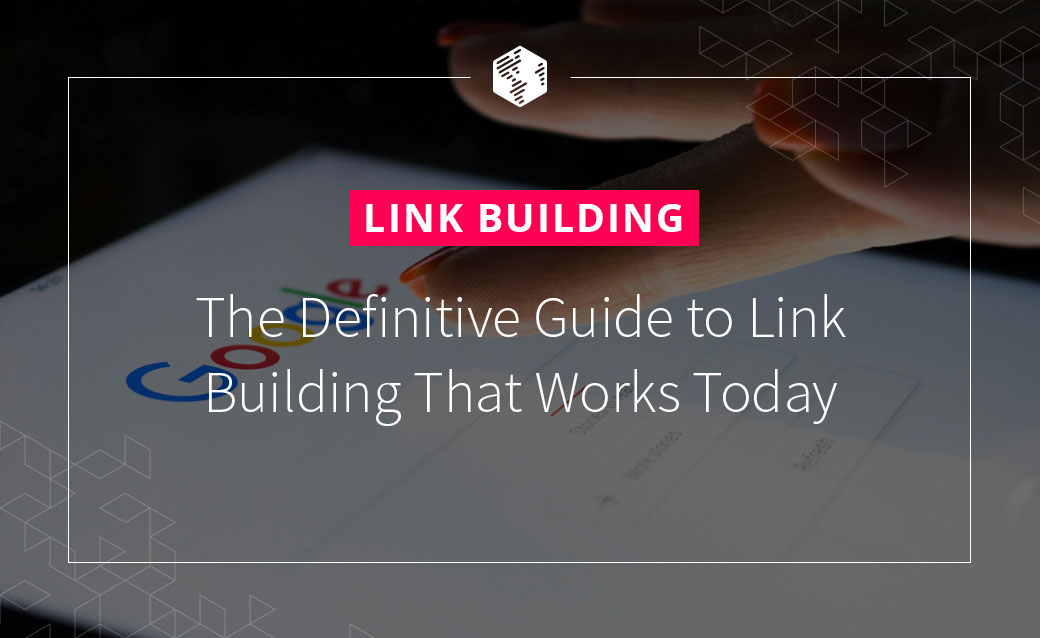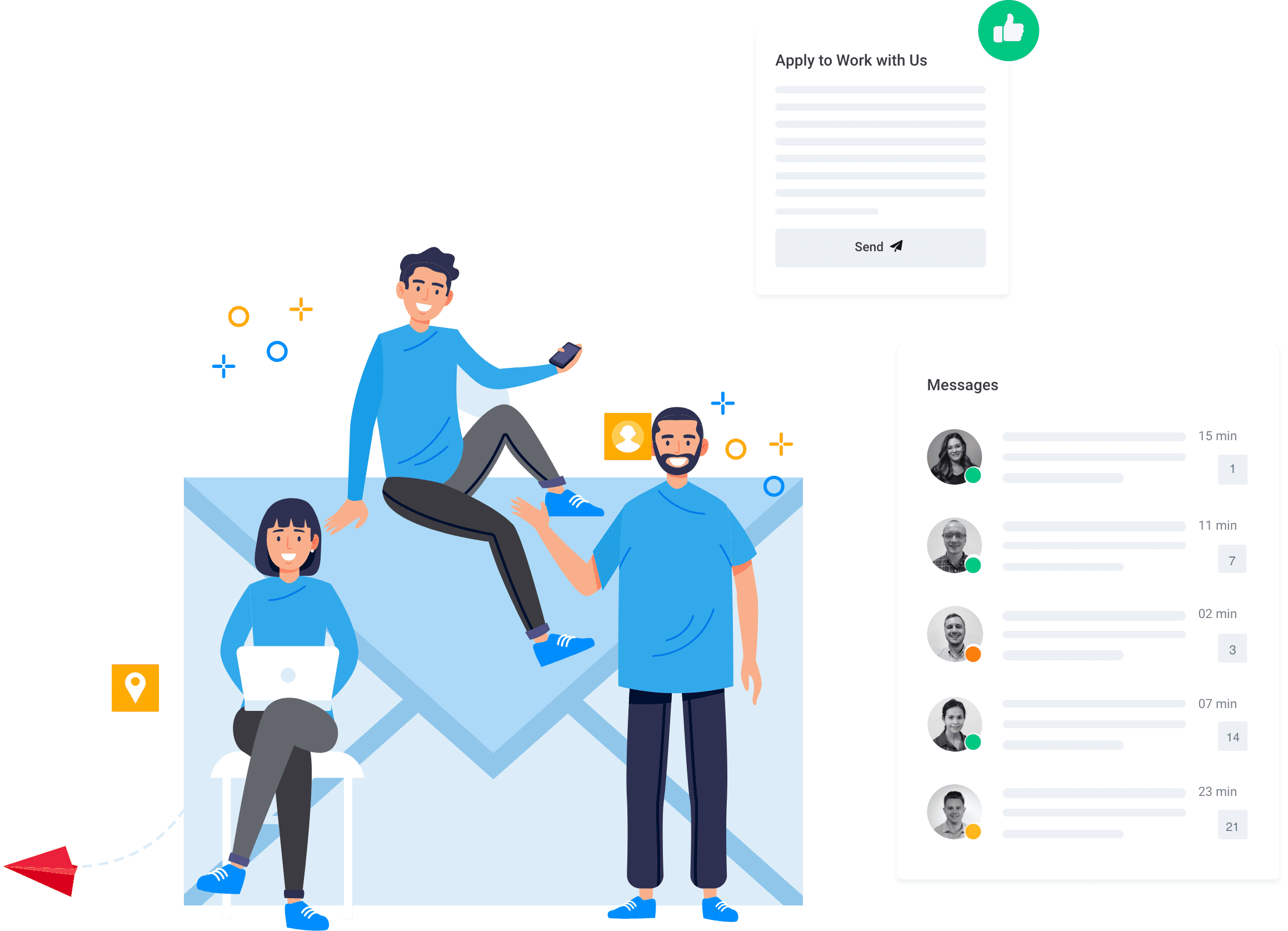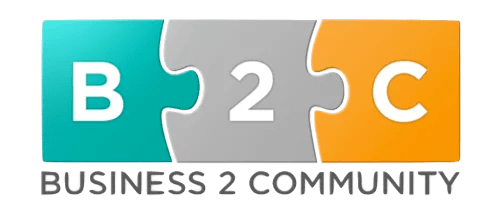Links are the lifeblood of your website.
Without high-quality links, your company’s website will not generate traffic or leads from search engines. Period!
Link building can be difficult especially if you’re just starting out. But I’ll show you the simple step-by-step guide that works for our 100+ clients.
Link building is the most important off-page SEO activity you can do for your website.
Many marketers fail to get results from their link building campaigns. Not because of a lack of effort. But because they’re not doing it the right way.
However, make no mistake, you can’t rank high for important keywords and gain lots of organic traffic without link building.
Perhaps, it’s no wonder that Google search analyst, Andrey Lipattsev, regards inbound links as one of the 3 most important ranking signals.
Having established the importance of link building, how do you go about it to get the best results for your website and business?
This guide will show you important strategies to follow and all other juicy details.
Let’s dive in.
What’s Link Building?
Link building is the process of acquiring links from external domains to your website.
To build quality links to your web pages, you’ll have to engage in activities like guest posting, link reclamation, producing quality content, outreach, etc.
Google and other search engines follow links to crawl pages. And one way Google gets confident in a page is through the backlinks to that page.
A backlink is a vote from an external website and most people would not link to poor pages.
Therefore, Google sees a page with many quality backlinks as a quality page and rank it higher for relevant keywords.
The point about link building is that while trying to do it right, you’ll be improving on other aspects of your website and branding that can improve your search performance and get you more customers.
For instance, you’d have to produce great content to have a chance at earning high-quality links from trusted sites.
You’d have to promote your content and build relationships with other influencers in your industry.
These are activities that would prove beneficial beyond building links.
As a marketer or SEO, building links is done primarily to improve search rankings. But building links for the sole aims of the links can tempt you to cut corners and gain poor results from the process.
Another question you may have in mind is: do you have to always build backlinks before getting them? Well, not always.
A part of link building is what is called “link earning.”
In this case, people find your content so good that they link to it without you asking. These are the best types of links you can get to your website.
Why is Link Building important?
As I’ve said earlier, the biggest reason to engage in link building is to improve your rankings on the search engine results page.
Other benefits you gain from this is that an improvement in your rankings, will lead to more organic traffic, leads, customers, and revenue.
Apart from that, other reasons that make link building important are:
1. Get Referral traffic
When you gain backlinks on other websites, visitors to those websites may end up clicking on those links to visit your website. You can see your referral sources from ‘All Traffic’ tab in Google Analytics.
This means you aren’t only gaining more traffic from search engine. But through the link itself.
For instance, when Patrik Edblad got his post featured on Lifehacker, it resulted in 14,625 visitors to his blog through the backlink.
2. Brand Building
Having your brand name or backlinks from many websites in your industry also helps to promote your brand.
Visitors to these websites see your name repeatedly and this helps to build your reputation in your niche.
3. Building relationships
To build links, you have to reach out to people regularly. In most cases, other websites are more likely to give you a backlink when you’ve built a relationship with the website owner.
Building relationships with influencers in your industry can even do more for your business than the links you build.
Forms of Backlinks
There are 2 forms of backlinks you can get from other websites:
i). Do-Follow links: These are links where the website indicates trust in the website they’re linking out to. This form of link gets link juice that helps to improve your search rankings.
ii). No-follow links: These are links that pass no link juice to the websites they link out to. They’re telling search engines that they don’t trust the website enough. A link like this doesn’t help a page receiving the link to rank higher.
This type of link is added to parts of websites like the comment section and ads.
Likewise, forums set their outgoing links as nofollow as many people add spam links to forums. The “rel=nofollow” tag is usually added to no-follow links.
Types of Link building
There are many types of links you can build for your website and they carry different levels of importance. The common types are:
1). Natural editorial links
Often while browsing pages online, you’ll notice that websites often link out to other websites in order to make a reference about a point.
Sometimes, it could be a link to research or a study. Generally, people do this to improve their content and provide more value to their readers.
Links you gain through this means, without asking, are usually the best. In this case, someone is voting for your content because they see it as valuable and not because you had to convince them.
Below, you can see a link to Rand Fishkin’s blog post on Search Engine Land while reporting he left Moz. This is an unsolicited link.
2). Manual outreach links
Of course, editorial backlinks are good. But as a beginner, you’re less likely to get them. Because people will only link to resources they’re aware of.
You’ll notice that popular websites that have established a reputation tend to get more editorial links than obscure ones.
Thus, the realistic means of gaining links if you’ve not established your reputation is to do it manually.
Activities to gain links manually include guest posting on other websites, tracking brand mentions, broken link building, etc.
What you’ll find is that most people engage in manual link building until they establish their reputation and start gaining editorial links.
You can see an example of a guest post by Gregory Ciotti, the Marketing Strategist at HelpScout. He links back to their website.
3). Self-created links
These are the links you create yourself and they’re the least valuable backlinks in terms of the link juice they pass to your website.
This type of link includes links from blog comments, adding your website to directories, including links in forum posts, etc.
These links are usually no-follow and you should limit them to avoid spam links. This is a comment on a blog with a link to the name.
Factors that Affect the Impact of Links
You’ve probably heard it before: links are not created equal. But what makes some links more valuable than others?
There are many factors that affect how valuable a backlink is and what impact it will have on your website:
1). Domain Authority
This is the ability of a domain to rank high in search engines. It’s a metric created by Moz and gives each website a score of between 0 and 100 with 100 being the highest.
It operates as a logarithmic scale and score website based on their ability to rank in reference to other websites.
For instance, a website with a domain authority of 80 will rank higher than one with a domain authority of 70 if they have similar pages and other factors are equal.
The domain authority rating of a website usually considers the number of backlinks the website has built over time.
Therefore, getting a backlink from a website with a domain authority of 80 will usually have more impact than a link from a website with a domain authority of 20.
2). Page Authority
Apart from the domain authority, another important factor is the page authority of the page linking out to your website.
For a particular website, there are different pages on the domain and they have different abilities to rank.
Some important pages on a website may have gained many backlinks over time that has given them the ability to rank higher than similar pages on the same website.
Getting backlinks from these pages will have a bigger impact than backlinks from pages with low authority.
To check the domain authority and page authority of any website you visit, you can download the MozBar extension for your browser.
3). The Relevance of Linking Page
Getting a backlink to your marketing website from a food website is usually not helpful. The best forms of links you can get are links from websites in your industry.
For instance, if you run a marketing website, then links from websites like HubSpot, OneIMS, Content Marketing Institute, Digital Marketing Institute, etc. are valuable to help you rank higher on search results.
But this is not a fast rule. For instance, if a medical website links to a post you wrote about marketing a medical practice, then the backlink is relevant considering the topic overlaps into both niches.
4). Anchor Text
The anchor text is the text on which the link is added. The anchor text tells the audience and search engine bots what the linked page is all about. Here’s an example:
If many websites link to your page with similar anchor texts, then it tells Google that your page is a valuable resource on that topic.
Over time, the impact of anchor texts has reduced as some SEO experts try to use some specific anchor text to influence the search rankings of their page.
5). Placement of the Link on The Page
Having your backlinks in some areas of a website is more valuable than some areas.
For instance, backlinks in comments, sidebars, or footers of websites carry less weight than backlinks in the body of page content.
Even in page content, backlinks close to the top of the page carry more weight than those closer to the end of the post.
6). Number of Linking Domains
The number of backlinks is usually higher than the number of linking domains. This is because a single domain may link to your website many times from different pages.
You can use the Moz Link Explorer to determine linking root domains.
It’s better to have many linking domains than to have so many backlinks from a few domains. In fact, having too many backlinks from a few domains is spammy and can get your website penalized by Google.
Link Building Strategies, Tactics, and Examples
The are many ways to build backlinks to your website. Of course, it needs to be said that building quality backlinks will usually require more work too.
Here are some strategies you can implement to gain more backlinks:
1. Create Link-worthy Content
The truth is that people want to link to quality content that will benefit their audience.
If you continuously produce low-quality content, then what you’ll gain is spammy or irrelevant links at best — which defeats the aim of building backlinks in the first place.
A link-worthy content is a piece of content that’s valuable and can convince other website owners to reference it on their sites.
Some examples of link-worthy content are:
a). Long-form Content
These are content that goes deep into a particular topic and aim to provide every information a reader might need about that topic.
This type of content has been proven to gain more backlinks and higher ranks in the past.
For instance, a study by Moz and BuzzSumo revealed that long-form content gains more social shares and the number of referring domain links than short content.
b). New trend
If there’s a new trend in your industry, then you can create a detailed guide for it before others.
This will help you gain backlinks to this content as most websites are still yet to have content on the new trend.
For instance, by creating a map that showed the real-life locations of Game of Thrones, Lawrence of Morocco was able to gain over 111 backlinks.
c). Original research or study
This can help to prove or discard a hypothesis in an industry. You can also use a study to support whatever statement you’re making. Therefore, studies tend to gain more backlinks as people can use it to support their ideas.
For instance, the Moz study mentioned above has gained about 2.7k backlinks from 1.1k domains.
d). Infographic
An infographic is a piece of content that helps you to explain concepts in a simple way.
Added to that, many people learn better with visual information than written text. In a study, people following directions with text and illustrations do 323% better than those following texts without directions.
A simple infographic titled “15 Grammar Goofs That Make You Look Silly,” which was published by Copyblogger Media generated close to 300,000 social shares, lots of leads, and revenue.
In fact, Brian Clark, the founder of Copyblogger has leveraged content marketing, driven by great content types like the infographic above to grow a $7 million company.
By making an infographic and promoting it, WordStream was able to gain close to 3,500 backlinks from websites like CNN.com, Fortune.com, Techcrunch, etc.
e). Video
A video tutorial on a topic can help you get backlinks from posts written about that topic. This video will provide an added value to the written text as readers can watch and follow the instructions.
f). White paper
White papers and eBooks can help you increase conversions rate.
A white paper, for instance, can help you increase your initial conversion rate.
According to Salesforce, you need 6 to 8 engaging touchpoints with your lead to generate sales.
A company can produce white papers that go into technical details of some parts of their service or product. This is usually beneficial to potential customers who want to be aware of the nitty-gritty of your product.
g). Ego Bait Content
Even though people would like to tell you otherwise, they’re the most important person to themselves. Ego bait content tends to show other people as experts in their careers or work.
For instance, a blog post about the best food bloggers online will appeal to someone who appears on the list. In this case, you can reach out to the bloggers on that list to share it on social media or link to it in one of their posts.
Although not all of them will link to their content, many will be willing to share on social media.
This can improve your post’s popularity and attract more links this way. Furthermore, you can build a relationship with the influencer and still collaborate later in the future — maybe through a guest post on their blog.
However, the key to creating ego bait content is that you have people or blogs that are truly big on your post as this will encourage an influencer to share.
An influencer won’t share a post if they don’t want to be associated with other people or blogs on your list.
See some examples of pages you can call ego bait below:
h). Guest Posting
This is one of the most effective link building strategies. In 2014, Google’s former head of Web Spam, Matt Cutts said: “stick a fork in it: guest blogging is done.”
But the truth is that guest posting is far from dead.
It still works even until today. Having said that, it’s dead if you’re posting poor content on spam websites just to gain links. You won’t gain benefits for your link building efforts this way.
In fact, you’re likely to incur a Google penalty instead. While you’re guest posting to build backlinks to your website, you should also provide valuable content that can solve problems for your audience.
Apart from link building, guest posting is an opportunity to reach a new audience. Writing guest posts with the aim to provide solutions to people’s problems will help you to gain more followers and loyal readers of your website.
Considering that you’re trying to produce the best possible content, you should also ensure you’re guest posting on reputable websites.
These websites pass more authority to your website and put you at low risk of receiving a penalty.
What are the points to keep in mind during your guest posting campaign?
1). Find authoritative websites that accept guest posts in your industry
To get the best link building impact through your guest posts, you should publish on authoritative websites. You probably know some of them already. But there are many more you can uncover with a bit of research.
In another sense, not all authoritative websites in your industry accept guest posts. You have to find those that accept guest posts. One way to do this is to use Google operators to find websites in your niche that accept guest posts.
For instance, if you’re in the fitness industry, you can use the intitle operator to find websites with fitness in the inurl to find a keyword like “Write for us” in the URL.
You can use these search operators and vary the keywords until you have a list of websites to target.
Another way to find guest post opportunities is to use a tool like Ahrefs. You can search for a topic and restrict your results to a page per domain. For instance, a keyword like “parenting” will give you 26,248 results.
You can find enough targets here. Another way to find guest posting opportunities is to look at where your competitors are publishing theirs. To do this, find their backlinks through tools like Ahrefs or SEMrush.
Enter your competitor’s website into Ahrefs Site Explorer and click on the search button.
You’ll see backlinks to their websites. You’ll find that some of these backlinks are from guest posts. You can target these websites for your guest post’s too.
2). Research on topics they’re yet to cover extensively
To give your guest post the best chance of acceptance, you should send over a topic that has not been covered extensively on your target website. But how do you do this when the website probably have thousands of posts?
You can search the website if it has a search box. If it doesn’t, you can use the Google site search operator. Enter the topic you want to write about and see the posts they have about that topic.
This could lead you to a new angle you can write about.
For instance, if you want to write about voice search for Search Engine Journal, then you can use the site search operator to see the content they have about the topic.
3). Create the best content possible
When you write a guest post, one of the main benefits for you is that you gain a precious backlink.
However, one of the main benefits your host wants to gain is that you provide a piece of content that is valuable to their audience.
And this is the type of guest posts that will help you build your authority. So a great post is a win-win for everybody.
Danny Iny, founder of Mirasee (formerly, Firepole Marketing) grow his multimillion-dollar business by guest posting on authoritative blogs in the business industry.
The success stories are just endless. GrooveHQ reached 1 million people via guest blogging.
4). Link Reclamation
Gaining backlinks is hard.
But what if you start losing the impact of the links you worked so hard to build? Or you’re at the risk of losing those links?
Nobody wants to be in this position. But over time, many marketers find themselves there. This could be due to a change in web hosts or other changes on your website that have caused your page URLs to change.
When you face such a situation, there are steps you can take to gain link juice from these links back. There are 2 common reasons for link reclamation which are:
5). Broken Link or Error 404 on Your Page
This occurs when a page on your website shows no content to visitors. If this page has built backlinks initially, then any visitor through these backlinks will find an empty page and gain no value from your website.
More so, these links are passing authority to an empty page.
If this continues for too long, websites linking to this page could edit their links and link to another page instead. Apart from losing the link juice, you could lose the link altogether.
You need to find your broken pages first of all. There are many tools you can use to find broken pages on your website. I’ll show you how to use the Moz Link Explorer
To use this tool, enter your website address into the tool and click on “Search.” After that, click on “Top Pages.”
Not all broken pages will be worth your attention. But you want to find top broken pages that have many backlinks. Click on the “Export to CSV” option to get a list of the top pages on your website.
If you’re using the new Moz Link Explorer, you can follow the same steps to get your list.
Open your list in Excel. To sort the broken pages out, you need to apply a filter. Select 404 and 302 to see the links that are broken or that are only temporary redirects.
After applying the filter, you can see the top broken pages in terms of page authority and number of backlinks.
If you want to get a list of important backlinks you need to reclaim, copy your web page address and enter it into the Link Explorer.
After that, click on the drop-down beside the box and select “exact page.”
To see the most important backlinks to your page, set the parameters for link type as “Follow” and link status as “Active.” You can export this data to see the backlinks to reclaim.
After collating a list of backlinks to a particular page, the possible actions to take to regain the power of these backlinks are:
i). Permanent redirect 301: This is the easiest and most effective step you can use to reclaim your links.
All you have to do is redirect the traffic to this broken page to your new page with the same content or similar content.
This will pass the link juice to this new page and help the page to rank. Furthermore, you’ll continue to provide value to people who visit your website through the link.
ii). Contact webmaster: Another way to reclaim your links is to contact the webmasters of websites that have linked to your page.
You can send them a new link they can add to replace the old one. This is less effective as not all webmasters will reply to your message.
Through link reclamation, Atlassian gained 118 extra backlinks to their French domain and 164 links to the German.
iii). Brand mentions without links: After a period of doing business online, it’s natural to have people mention your business in their content.
This will even be common if you’ve established a positive reputation with your work.
Unfortunately, most of these mentions will be without links. This is an opportunity you can exploit to gain more links to your website.
Someone who mentions your website in their content will be more receptive to adding a link to the mention.
But first of all, you have to find these mentions. To do that effectively, you need to use tools that can help you find them. Some tools you can use are Google Alert, Mention, BuzzSumo, etc.
To use BuzzSumo to find mentions, you can select brand mentions, competitor mentions, or any of the 6 options you have.
After doing this, enter the details of the brand you want to mention. Click on “Next.”
On the next page, you can select how you want to be alerted whenever your brand is mentioned online. Click on “Next.”
Apart from the alerts you’ve set, you can also see any mention of your brand on the BuzzSumo dashboard.
After finding these mentions, you can contact webmasters of pages you want to gain backlinks from.
Not all the mentions will lead to backlinks, but you’ll find websites that can pass authority to your website through a backlink.
With the aid of brand mention and competitive research, Andrew Dennis gained 64 backlinks and a 43% increase in organic traffic to a website in 6 months.
6. Broken Link Building
This is a little bit different from link reclamation. What you’re doing here is looking for broken links on other websites that you can replace with yours.
In some cases, an outbound link from a website may lead to a broken page.
When you find a case like this, you can contact the webmaster of such a page to inform them of the broken link and then provide a link to your own page that’s similar.
If you’ve produced valuable content, the webmaster could replace the broken link with yours to provide a better value for their users.
You can use a tool like the Dead Link Checker to find broken link opportunities for a particular keyword.
You can also use a tool like Ahrefs. Enter the website you want to gain a link from and click on outgoing links and then broken links.
This will show you outbound links from this website that are broken. You can write a similar post to this and offer it instead.
To even gain more backlinks, you can enter this broken link into Ahrefs to see other websites that linked to it.
7. Link Building Outreach
An important part of link building is engaging in outreach to people who will link to your content. If you do this wrong, then you have a lower chance of getting a backlink.
It’s always easier if you’re reaching out to someone you already have a relationship with and this is my advice.
But it’s not always possible. In some cases, the outreach could be your way of building a relationship with an influencer.
How do you go about your outreach to get the best results possible?
a). Use an attractive subject line: Your email can easily end up in your recipient’s spam folder if you use the wrong subject line. You should use a subject line that’s likely to attract the influencer you’re sending your message to.
b). Go straight to the point: At the time of sending your email, you’re still a stranger to the influencer. It’s better to tell them why you’re sending the message without telling your life story.
Check out the example below:
It shows the sender had actually been reading the influencer’s blog post and the email goes straight to the point.
c). Stress benefit to their audience: Having a backlink is a benefit to you. But what’s the benefit to the authority figure or their audience? You should have this in your outreach email.
d). Follow up: The norm is that you won’t get a reply for your first email especially if you’ve sent an email to a popular influencer in your field.
These are people who receive tons of email daily. Sometimes, they may think of reading your email but forget in the long run.
When you send a reminder to them, you bring your message back to their consciousness and improve your chances of getting a reply. An important question is: how many times should you follow up with an influencer?
It depends. If you get no reply after following up twice, then you should reach out to other influencers.
While you’re trying to reach out to an influencer, you don’t want to get the opposite result of them seeing you as a spammer.
See an example of a follow-up email:
Final thoughts
Building backlinks require the right strategies and patience. Nobody builds a ton of traffic overnight.
But link building is a worthwhile task. Because apart from gaining links, it helps you to improve other parts of your website, such as web traffic, leads, and sales.
Don’t just read this guide and move on. Follow the strategies here and you’ll see positive results in your search rankings. If you have questions about link building or how you can get started, OneIMS can help you. Talk a Strategist today.































